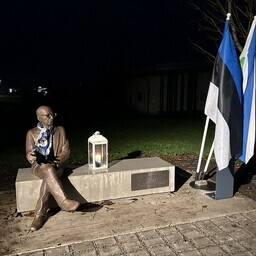Pingil istuva metsavenna Ruuben Lamburi skulptuur paigaldati Rakvere vallas asuva Sõmeru keskushoone ette.
Ruuben Lambur oli koos oma abikaasa Leidaga sagedane
külaline Sõmeru majas
. Nad käisid seal igal esmaspäeval
eakate kokkusaamistel
, kontsertidel ja tantsupidudel. Skulptuuri püstitamise eestvedaja Peep Vassiljev ütles: "
Olge positiivsed ja optimistlikud
, siis elame kauem ja rõõmsamalt."
külaline Sõmeru majas
Tõlge fraasile: külaline Sõmeru majas
EN
guest at the Sõmeru house
eakate kokkusaamistel
Tõlge fraasile: eakate kokkusaamistel
EN
at elderly gatherings
Olge positiivsed ja optimistlikud
Tõlge fraasile: Olge positiivsed ja optimistlikud
EN
Be positive and optimistic
Skulptor Aivar Simson oli skulptuuri loomisel. Tema jaoks oli kõige keerulisem teha pealage ja prille. Simson ütles: "Mulle meeldis, et Ruuben kasutas käsi, kui sõnad otsa said. Kätega on hea emotsioone edasi anda."
Ruuben Lamburi tütar Meret Oja oli kunstiteosega rahul. Ta ütles: "
Pronksist kuju
ei saa olla täpselt inimese moodi, aga teatud nurkade all on see väga isa moodi. Simson on tabanud hästi liikumise ning see kuju tundub nagu ta hakkaks kohe midagi ütlema."
Pronksist kuju
Tõlge fraasile: Pronksist kuju
EN
bronze statue
Skulptuuri avamisega tähistati eelmise aasta kevadel Ruuben Lamburi 100. sünniaastapäeva.
Ruuben Lambur sündis Järvakandis 13. novembril 1925. aastal. Tema sünnipäeva peeti kaua aega 13. märtsil, sest dokumentidesse oli kirjutatud vale kuupäev.
1932. aastal kolis tema pere Peresaare asundustalude külla. 1941. aastal põgenes Ruuben nõukogude mobilisatsiooni eest metsa. Ta liitus Eesti Leegioniga, kuid sai vigastada ja jäi väeosast maha. Seejärel algas tema
metsavenna eluperiood
aastatel 1944-1947. Vangi langedes saadeti ta
Gulagi vangilaagrisse
, kust ta vabanes 1965. aastal.
metsavenna eluperiood
Tõlge fraasile: metsavenna eluperiood
EN
forest brother period
Gulagi vangilaagrisse
Tõlge fraasile: Gulagi vangilaagrisse
EN
to the Gulag labor camp
Ruuben Lambur kirjutas oma elust raamatus "
Alutaguse saaga
". Raamatu põhjal tehti teatris muusikaline dokumentaaldraama "
Viimane
metsavend
"
data-translations='{"en":"The Last Forest Brother","ru":"Последний лесной брат","uk":"Останній лісовий брат"}'
data-article-title=""
data-article-id="0978e6b0-4775-40f8-a564-e3f441083145"
aria-label="Save phrase"
title="Salvesta fraas">
-->
".
Alutaguse saaga
Tõlge fraasile: Alutaguse saaga
EN
The Saga of Alutaguse
metsavend
Tõlge fraasile: metsavend
EN
forest brother
metsavend
Tõlge fraasile: metsavend
EN
forest brother
Viimane
metsavend
metsavend
Tõlge fraasile: metsavend
EN
forest brother
Tõlge fraasile: Viimane
metsavend
metsavend
Tõlge fraasile: metsavend
EN
forest brother
EN
The Last Forest Brother
Ruuben Lambur lahkus 2023. aasta kevadel. Ta on maetud Tõrma kalmistule, kuhu püstitati tema mälestuskivi.
The sculpture of Forest Brother Ruuben Lambur sitting on a bench was installed in front of the Sõmeru community center in Rakvere Parish.
Ruuben Lambur, along with his wife Leida, was a frequent visitor to the Sõmeru house. They attended seniors’ gatherings, concerts, and dance parties there every Monday. The initiator of the sculpture, Peep Vassiljev, said, "Be positive and optimistic, and we will live longer and happier lives."
Sculptor Aivar Simson created the sculpture. For him, the most challenging parts were the crown of the head and the glasses. Simson said, "I liked that Ruuben used his hands when words ran out. Hands are good for conveying emotions."
Ruuben Lambur's daughter, Meret Oja, was pleased with the artwork. She said, "A bronze statue cannot be exactly like a person, but from certain angles, it very much resembles my father. Simson has captured the movement well, and this statue seems as if it is about to say something."
The unveiling of the sculpture marked the 100th anniversary of Ruuben Lambur's birth last spring.
Ruuben Lambur was born in Järvakandi on November 13, 1925. His birthday was long celebrated on March 13 because the documents had the wrong date.
In 1932, his family moved to the Peresaare settlement farm. In 1941, Ruuben fled to the forest to escape Soviet mobilization. He joined the Estonian Legion but was injured and left behind. This marked the beginning of his period as a Forest Brother from 1944 to 1947. Captured, he was sent to the Gulag camp, from which he was released in 1965.
Ruuben Lambur wrote about his life in the book "Alutaguse Saga." Based on the book, a musical documentary drama "The Last Forest Brother" was made in the theater.
Ruuben Lambur passed away in the spring of 2023. He is buried in Tõrma Cemetery, where a memorial stone was erected in his honor.

